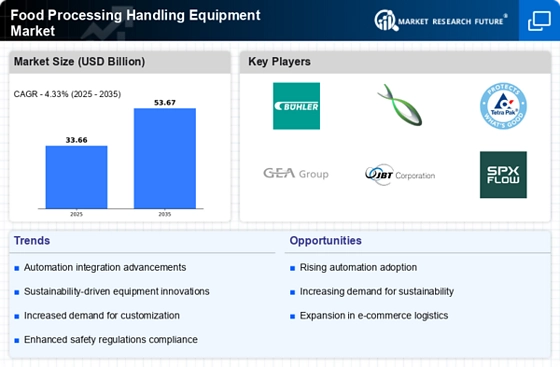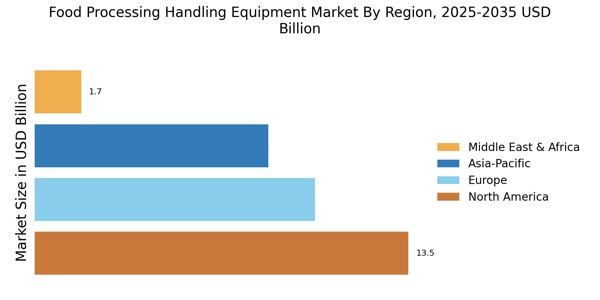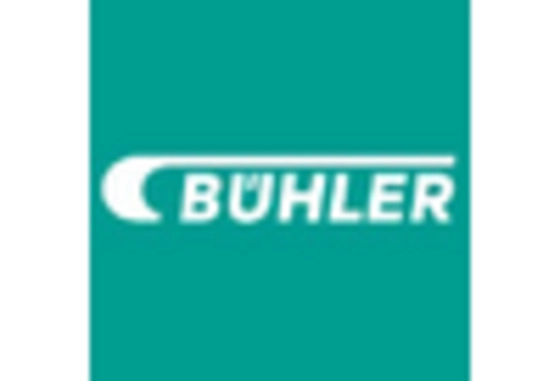Focus on Food Safety and Quality
The emphasis on food safety and quality assurance is a significant driver of the Food Processing Handling Equipment Market. With increasing regulatory scrutiny and consumer awareness regarding food safety, manufacturers are compelled to adopt equipment that meets high standards. The market is witnessing a surge in demand for handling equipment that incorporates features such as traceability and contamination prevention. Reports indicate that the food safety equipment market is expected to grow by approximately 6% annually, reflecting the industry's commitment to maintaining quality. This focus on safety not only protects consumers but also enhances brand reputation, thereby influencing purchasing decisions and driving growth in the Food Processing Handling Equipment Market.
Rising Demand for Processed Foods
The increasing demand for processed foods is a primary driver of the Food Processing Handling Equipment Market. As consumer lifestyles evolve, there is a noticeable shift towards convenience foods, which require efficient processing and handling. According to industry reports, the processed food sector is projected to grow at a compound annual growth rate of approximately 5.5% over the next few years. This growth necessitates advanced handling equipment to ensure quality and efficiency in production. Manufacturers are thus investing in innovative technologies to meet this demand, which in turn propels the Food Processing Handling Equipment Market forward. The need for equipment that can handle diverse food products, from frozen to ready-to-eat meals, is becoming increasingly critical.
Technological Advancements in Equipment
Technological advancements play a crucial role in shaping the Food Processing Handling Equipment Market. Innovations such as automation, robotics, and IoT integration are enhancing operational efficiency and reducing labor costs. For instance, automated handling systems can significantly minimize human error and increase throughput. The market for automated Food Processing Machinery is expected to witness substantial growth, with estimates suggesting a rise of around 7% annually. These advancements not only improve productivity but also ensure compliance with stringent food safety regulations. As manufacturers seek to optimize their processes, the demand for state-of-the-art handling equipment continues to escalate, driving the Food Processing Handling Equipment Market.
Sustainability and Eco-Friendly Practices
Sustainability initiatives are increasingly influencing the Food Processing Handling Equipment Market. As environmental concerns rise, manufacturers are seeking equipment that minimizes waste and energy consumption. The adoption of eco-friendly practices is not merely a trend but a necessity, with many companies aiming for zero waste in their operations. The market for sustainable food processing equipment is projected to grow significantly, with estimates suggesting a potential increase of around 8% in the coming years. This shift towards sustainability not only meets regulatory requirements but also appeals to environmentally conscious consumers, thereby driving demand for innovative handling solutions in the Food Processing Handling Equipment Market.
Growth of E-commerce and Online Food Delivery
The expansion of e-commerce and online food delivery services is reshaping the Food Processing Handling Equipment Market. As more consumers turn to online platforms for their food purchases, there is a heightened need for efficient processing and handling systems that can support rapid order fulfillment. The online food delivery market is expected to grow at a rate of approximately 10% annually, necessitating the development of equipment that can handle increased volumes and diverse product types. This trend compels manufacturers to invest in advanced handling solutions that ensure timely delivery and maintain product integrity. Consequently, the Food Processing Handling Equipment Market is poised for growth as it adapts to these evolving consumer behaviors.


















Leave a Comment